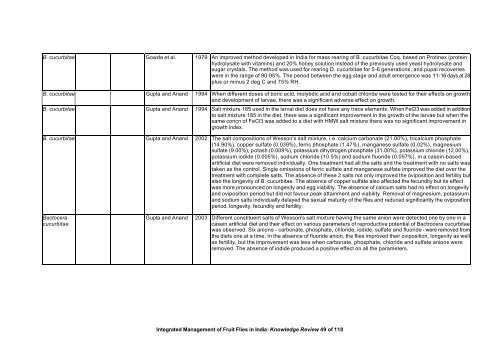“Key Informant Survey” of Production, Value, Losses and ... - DfID
“Key Informant Survey” of Production, Value, Losses and ... - DfID
“Key Informant Survey” of Production, Value, Losses and ... - DfID
Create successful ePaper yourself
Turn your PDF publications into a flip-book with our unique Google optimized e-Paper software.
B. cucurbitae Gowda et al. 1979 An improved method developed in India for mass rearing <strong>of</strong> B. cucurbitae Coq. based on Protinex (protein<br />
hydrolysate with vitamins) <strong>and</strong> 20% honey solution instead <strong>of</strong> the previously used yeast hydrolysate <strong>and</strong><br />
sugar crystals. The method was used for rearing D. cucurbitae for 5-6 generations, <strong>and</strong> pupal recoveries<br />
were in the range <strong>of</strong> 90-95%. The period between the egg stage <strong>and</strong> adult emergence was 11-16 days at 28<br />
plus or minus 2 deg C <strong>and</strong> 75% RH.<br />
B. cucurbitae Gupta <strong>and</strong> An<strong>and</strong> 1994 When different doses <strong>of</strong> boric acid, molybdic acid <strong>and</strong> cobalt chloride were tested for their effects on growth<br />
<strong>and</strong> development <strong>of</strong> larvae, there was a significant adverse effect on growth.<br />
B. cucurbitae Gupta <strong>and</strong> An<strong>and</strong> 1994 Salt mixture 185 used in the larval diet does not have any trace elements. When FeCl3 was added in addition<br />
to salt mixture 185 in the diet, there was a significant improvement in the growth <strong>of</strong> the larvae but when the<br />
same concn <strong>of</strong> FeCl3 was added to a diet with HMW salt mixture there was no significant improvement in<br />
growth index.<br />
B. cucurbitae Gupta <strong>and</strong> An<strong>and</strong> 2002 The salt compositions <strong>of</strong> Wesson's salt mixture, i.e. calcium carbonate (21.00%), tricalcium phosphate<br />
(14.90%), copper sulfate (0.039%), ferric phosphate (1.47%), manganese sulfate (0.02%), magnesium<br />
sulfate (9.00%), potash (0.009%), potassium dihydrogen phosphate (31.00%), potassium chloride (12.00%),<br />
potassium iodide (0.005%), sodium chloride (10.5%) <strong>and</strong> sodium fluoride (0.057%), in a casein-based<br />
artificial diet were removed individually. One treatment had all the salts <strong>and</strong> the treatment with no salts was<br />
taken as the control. Single omissions <strong>of</strong> ferric sulfate <strong>and</strong> manganese sulfate improved the diet over the<br />
treatment with complete salts. The absence <strong>of</strong> these 2 salts not only improved the oviposition <strong>and</strong> fertility but<br />
also the longevity <strong>of</strong> B. cucurbitae. The absence <strong>of</strong> copper sulfate also affected the fecundity but its effect<br />
was more pronounced on longevity <strong>and</strong> egg viability. The absence <strong>of</strong> calcium salts had no effect on longevity<br />
<strong>and</strong> oviposition period but did not favour peak attainment <strong>and</strong> viability. Removal <strong>of</strong> magnesium, potassium<br />
<strong>and</strong> sodium salts individually delayed the sexual maturity <strong>of</strong> the flies <strong>and</strong> reduced significantly the oviposition<br />
period, longevity, fecundity <strong>and</strong> fertility.<br />
Bactocera<br />
cucurbitae<br />
Gupta <strong>and</strong> An<strong>and</strong> 2003 Different constituent salts <strong>of</strong> Wesson's salt mixture having the same anion were detected one by one in a<br />
casein artificial diet <strong>and</strong> their effect on various parameters <strong>of</strong> reproductive potential <strong>of</strong> Bactrocera cucurbitae<br />
was observed. Six anions - carbonate, phosphate, chloride, iodide, sulfate <strong>and</strong> fluoride - were removed from<br />
the diets one at a time. In the absence <strong>of</strong> fluoride anion, the flies improved their oviposition, longevity as well<br />
as fertility, but the improvement was less when carbonate, phosphate, chloride <strong>and</strong> sulfate anions were<br />
removed. The absence <strong>of</strong> iodide produced a positive effect on all the parameters.<br />
Integrated Management <strong>of</strong> Fruit Flies in India: Knowledge Review 49 <strong>of</strong> 110

















